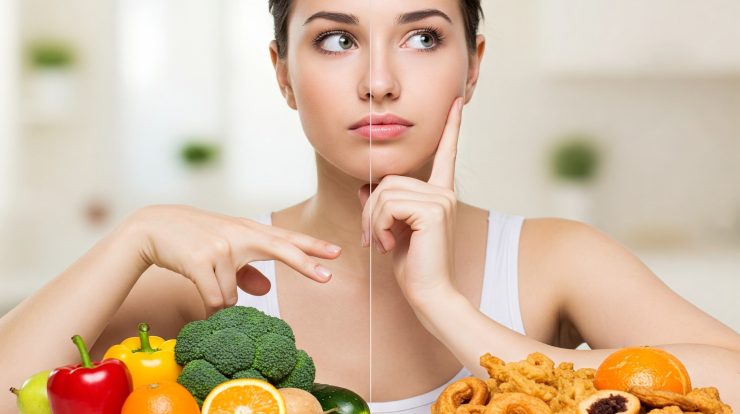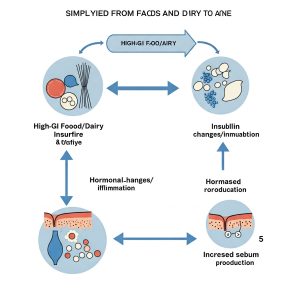
For decades, the question of whether diet influences acne breakouts has been debated among dermatologists, nutritionists, and anyone who’s ever experienced a pimple after indulging in certain foods. While genetics, hormones, bacteria (specifically Cutibacterium acnes), and inflammation are known primary drivers of acne, the role of diet is becoming increasingly recognized as a potential contributing factor for some individuals. So, can changing what you eat really impact your skin? Let’s dive into what the current scientific understanding suggests as of early 2025.
The Diet-Acne Connection: What Does the Science Say?

Historically, the link between diet and acne was often dismissed by the medical community. However, recent research, including observational studies and some controlled trials, has begun to shed more light on potential connections.
It’s crucial to understand that for most people, diet is not the sole cause of acne. However, evidence increasingly suggests that certain dietary patterns and specific foods can influence or worsen acne breakouts in susceptible individuals. The mechanisms often involve hormonal fluctuations, inflammation, and changes in sebum (skin oil) production triggered by how our bodies process certain foods.
Potential Dietary Culprits Linked to Acne
Research points towards a few key dietary factors that may influence acne development or severity in some people:
High-Glycemic Index (GI) Foods
- What they are: These are foods that cause a rapid spike in blood sugar and insulin levels after consumption. Examples include refined carbohydrates (white bread, white rice, pastries, sugary cereals), sugary drinks, sweets, and processed snacks.
- The Proposed Mechanism: Eating high-GI foods leads to a surge in insulin and insulin-like growth factor 1 (IGF-1). These hormones can:
- Increase sebum production.
- Stimulate the production of androgens (hormones linked to acne).
- Promote inflammation throughout the body, including the skin.
- The Evidence: Several studies have observed a correlation between diets high in high-GI foods and increased acne prevalence or severity. Some intervention studies where participants switched to a low-GI diet showed improvements in acne.
Dairy Products (Especially Skim Milk)
- What it is: Milk and milk-derived products.
- The Proposed Mechanism: The link isn’t fully understood, but potential mechanisms include:
- Hormones naturally present in milk (even organic milk) may influence the body’s own hormones.
- Dairy proteins can increase IGF-1 levels, similar to high-GI foods.
- Some studies suggest skim milk has a stronger association than whole milk, though the reasons aren’t entirely clear.
- The Evidence: Several large observational studies have found an association between higher milk intake (particularly skim milk) and acne in teenagers and young adults. However, the evidence is not conclusive for everyone, and the role of yogurt and cheese seems less clear, possibly due to fermentation processes. More research is needed, especially randomized controlled trials.
Whey Protein Supplements
- What it is: A popular protein supplement derived from milk.
- The Evidence: Anecdotal reports and some case studies suggest a link between whey protein supplementation and the onset or worsening of acne. This is often hypothesized to be related to its effect on increasing IGF-1 levels.
Saturated and Trans Fats (Less Strong Evidence)
- What they are: Found in fatty meats, processed foods, fried foods, and some baked goods.
- The Proposed Mechanism: Diets high in certain unhealthy fats may promote overall inflammation in the body, which could potentially exacerbate inflammatory acne.
- The Evidence: The link between specific fats and acne is less well-established compared to high-GI foods and dairy. Focusing on healthy fats (like omega-3s) is generally recommended for overall health.
What About Chocolate and Greasy Foods?
These are two common myths:
- Chocolate: For years, chocolate was blamed for breakouts. However, most studies haven’t found a direct link between pure cocoa and acne. The culprit is more likely the high sugar and dairy content often found in milk chocolate bars and sweets. Dark chocolate (with high cocoa content and low sugar) is less likely to be problematic.
- Greasy Foods: Eating greasy foods (like pizza or fries) doesn’t directly cause acne. However, working in a greasy environment (like a kitchen) where grease can physically block pores can contribute to breakouts (a type called acne mechanica).
Foods That Might Help Acne?
While the focus is often on what not to eat, some dietary factors may be beneficial for skin health, although more robust research is needed:
- Low-Glycemic Index Diet: Focusing on whole grains, legumes, fruits, and vegetables.
- Omega-3 Fatty Acids: Found in fatty fish (salmon, mackerel), flaxseeds, and walnuts; known for their anti-inflammatory properties.
- Antioxidants: Abundant in colorful fruits and vegetables; help combat inflammation.
- Zinc: Found in nuts, seeds, meat, and legumes; plays a role in skin health and inflammation.
- Probiotics: Found in fermented foods (yogurt, kefir, kimchi); may influence the gut-skin axis and reduce inflammation.
Focusing on a balanced diet rich in whole, unprocessed foods is generally beneficial for overall health, including skin health.
Individual Variation is Key
It cannot be stressed enough: acne triggers are highly individual. A food that causes breakouts in one person may have no effect on another. Genetics play a significant role in determining your susceptibility.
Practical Advice
- Focus on Overall Diet Quality: Prioritize whole, unprocessed foods, fruits, vegetables, lean protein, and healthy fats. Limit processed foods, sugary drinks, and excessive refined carbohydrates.
- Consider a Food Diary: If you suspect specific foods are triggers, keep a detailed diary of what you eat and when breakouts occur. This can help identify personal patterns.
- Trial Elimination (Under Guidance): If you strongly suspect dairy or high-GI foods, you could try eliminating them one at a time for several weeks (at least 4-6 weeks) to see if your skin improves. It’s best to do this under the guidance of a doctor, dermatologist, or registered dietitian.
- Don’t Expect Miracles: Diet is usually just one piece of the puzzle. It’s unlikely to completely cure moderate to severe acne on its own.
- Consult Professionals: Always see a doctor or dermatologist for an accurate acne diagnosis and treatment plan. They can recommend effective topical or oral medications and provide personalized dietary advice based on your specific situation.
Conclusion
While not the sole cause, evidence suggests diet can play a role in influencing acne breakouts for some individuals. High-glycemic index foods and potentially dairy products (especially skim milk) are the most studied dietary factors with links to acne. However, individual responses vary greatly. Focusing on a balanced, whole-foods diet is beneficial for overall skin health, but dietary changes should be seen as a complementary approach alongside proper skincare and, when necessary, medical treatment recommended by a dermatologist.
